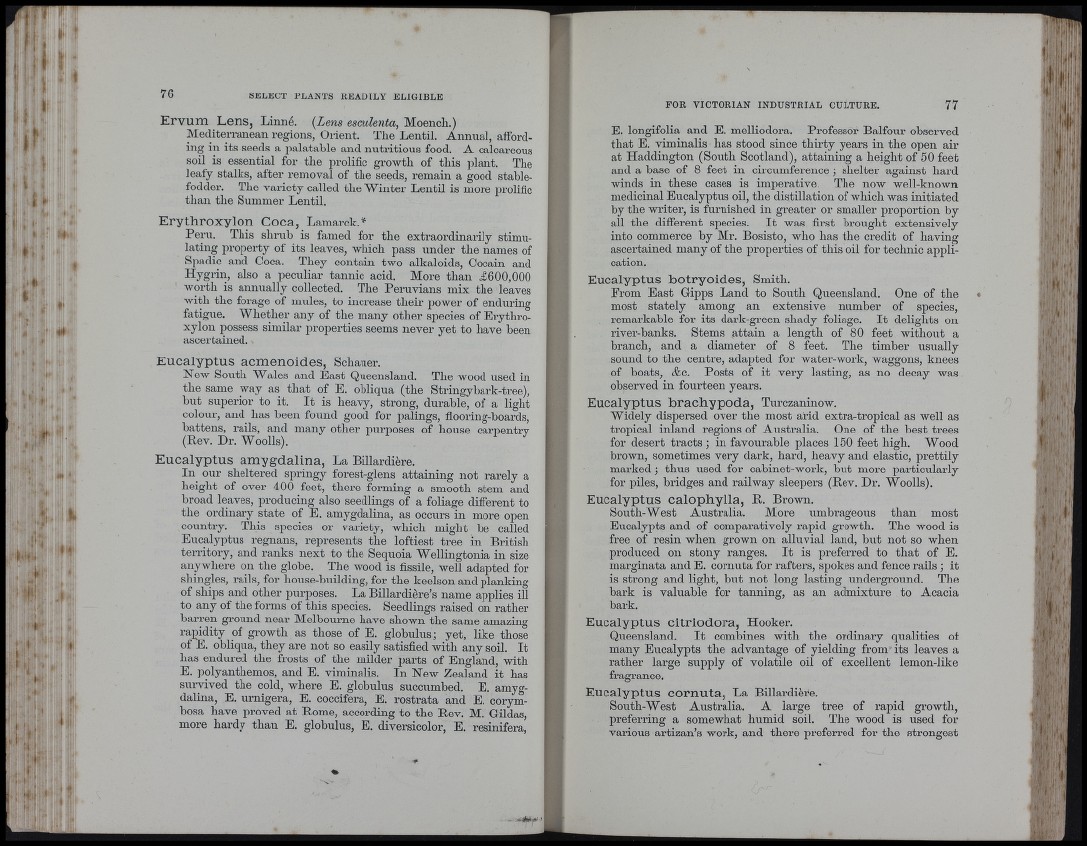
ì< I ì
H
Hit
•II»
Ervum Lens, Linné. {Lens esculenta, Moench.)
Mediterranean regions, Orient. The Lentil. Annual, affording
in its seeds a palatable and nutritious food. A calcareous
soil is essential for the prolific growth of this plant. The
leafy stalks, after removal of the seeds, remain a good stable-
fodder. The variety called the Winter Lentil is more prolific
than the Summer Lentil.
Erytbroxylon Coca, Lamarck.*
Peru. This shrub is famed for the extraordinarily stimulating
property of its leaves, which pass under the names of
Spadic and Coca. They contain two alkaloids, Cocain and
Hygrin, also a peculiar tannic acid. More than £600,000
worth is annually collected. The Peruvians mix the leaves
A v ith the forage of mules, to increase their power of endurmg
fatigue. Whether any of the many other species of Erythro-
xylon possess similar properties seems never yet to have been
ascertained.
Eucalyptus acmenoides, Schauer.
New Soutli Wales and East Queensland. The wood used in
the same way as that of E. obliqua (the Stringybark-tree),
but superior to it. I t is heavy, strong, durable, of a light
colour, and has been found good for palings, fiooring-boards,
battens, rails, and many other purposes of house carpentry
(Rev. Dr. Woolls).
Eucalyptus amygdaliua. La Biliardière.
In onr sheltered springy forest-glens attaining not rarely a
height of over 400 feet, there forming a smooth stem and
broad leaves, producing also seedlings of a foliage different to
the ordinary state of E. amygdalina, as occurs in more open
country. This species or variety, which might be called
Eucalyptus regnans, represents tbe loftiest tree in British
territory, and ranks next to the Sequoia Wellingtonia in size
anywhere on the globe. The wood is fissile, well adapted for
shingles, rails, for liouse-building, for tbe keelson and planking
of skips and other purposes. La Billardière’s name applies ill
to any of the forms of this species. Seedlings raised on rather
barren ground near Melbourne have shown tbe same
rajfidity of growth as those of E. globulus; yet, like those
of E. obliqua, they are not so easily satisfied with any soil. It
lias endured tbe frosts of the milder parts of England, with
E. polyanthemos, and E. viminalis. In New Zealand it has
survived the cold, where E. globulus succumbed. E. amygdalina,
E. urnigera, E. coccifera, E. rostrata and E. corym-
bosa have proved at Borne, according to the Rev. M. Gildas,
more hardy than E. globulus, E. diversicolor, E. resinifera,
FOR VICTORIAN INDUSTRIAL CULTURE. 77
E. longifolia and E. melliodora. Professor Balfour observed
that E. viminalis has stood since thirty years in the open air
at Haddington (South Scotland), attaining a height of 50 feet
and a base of 8 feet in circumference ; shelter against bard
winds in these cases is imperative, The now well-known
medicinal Eucalyptus oil, tbe distillation of which was initiated
by the writer, is furnished in greater or smaller proportion by
all the different species. I t was first brought extensively
into commerce by Mr. Bosisto, who has the credit of having
ascertained many of the properties of this oil for technic application.
Eucalyptus botryoides, Smith.
Erom East Gipps Land to South Queensland. One of the
most stately among an extensive number of species,
remarkable for its dark-green shady foliage. I t delights on
river-banks. Stems attain a length of 80 feet without a
branch, and a diameter of 8 feet. The timber usually
sound to tbe centre, adapted for water-work, waggons, knees
of boats, (fee. Posts of it very lasting, as no decay was
observed in fourteen years.
Eucalyptus bracbypoda, Turczaninow.
Widely dispersed over the most arid extra-tropical as well as
tropical inland regions of Australia. One of the best trees
for desert tracts ; in favourable places 150 feet high. Wood
brown, sometimes very dark, hard, heavy and elastic, prettily
marked ; thus used for cabinet-work, but more particularly
for piles, bridges and railway sleepers (Rev. Dr. Woolls).
Eucalyptus calopbylla, R. Brown.
South-West Australia. More umbrageous than most
Encalypts and of comparatively rapid growth. The wood is
free of resin when grown on alluvial land, bnt not so when
produced on stony ranges. I t is preferred to th a t of E.
marginata and E. cornuta for rafters, spokes and fence rails ; it
is strong and light, bnt not long lasting underground. The
bark is valuable for tanning, as an admixture to Acacia
baik.
Eucalyptus citriodora, Hooker.
Queensland. I t combines with the ordinary qualities ot
many Encalypts the advantage of yielding from® its leaves a
rather large supply of volatile oil of excellent lemon-like
fragrance.
Eucalyptus cornuta, La Biliardière.
South-West Australia. A large tree of rapid gi’owth,
preferring a somewhat humid soil. The wood is used for
various artizan’s work, and there preferred for the strongest
1 ' ' u
V :
'I